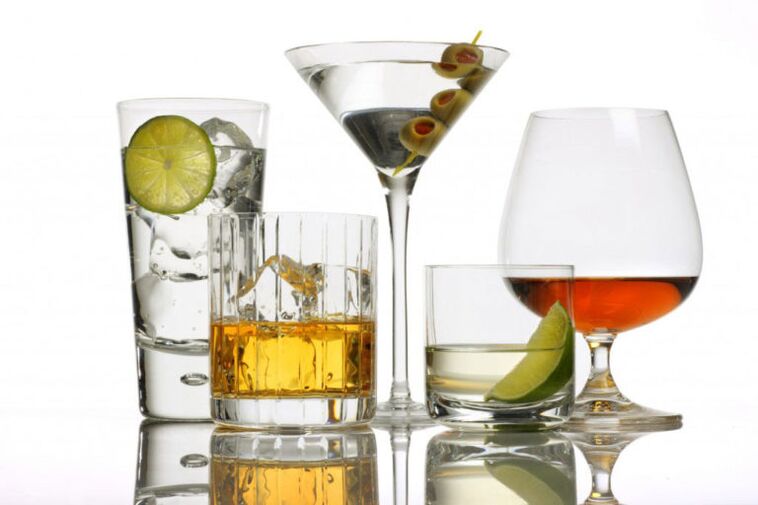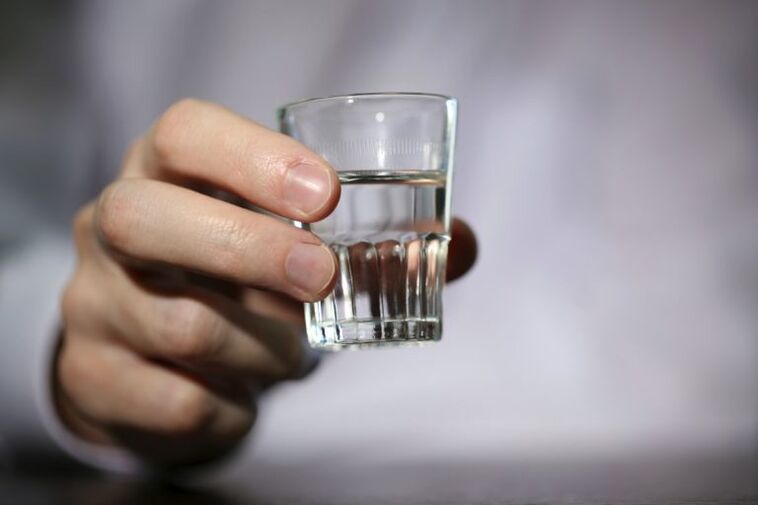Alcoholic beverages are acceptable in small quantities. This is confirmed by any medical staff. The limitation is associated with the negative effects of ethanol on organ systems. Many understand the seriousness of the problem and are aware of the seriousness of the consequences of alcohol abuse, therefore they are interested in how much is considered acceptable or, on the contrary, harmless.
Benefits of Alcohol
There is an opinion that alcohol in reasonable doses is beneficial to health, so drinking it is not prohibited. The beneficial effect on the circulatory system is mentioned most frequently. So, ethyl alcohol - the main component of an alcoholic beverage - helps dissolve cholesterol plaques that form on the inner walls of blood vessels. Their presence indicates a disease such as atherosclerosis. The disease often develops with a violation of diet and the use of large amounts of animal fats, which tend to turn into "bad" cholesterol or low-density triglycerides. These compounds clog the lumen of the arteries and disrupt the free flow of blood.

Another valuable property of alcoholic beverages is the ability to quickly relax and relieve stress. Even a small dose of a strong drink will cheer you up and improve your emotional state. This is due to an increase in the concentration of happiness and pleasure hormones.
Of course, all valuable properties will be expressed when drinking quality alcohol, so the choice of alcohol should be carefully considered. The type of product also plays a role. So, the maximum benefit is dry wine or cognac. These powerful drinks contain bioflavonoids, vitamins and antioxidants.
It turns out that when used wisely, alcohol can actually be beneficial. There are many nuances that will help make drinking alcohol safe.
Is it possible to drink without harm to health
Doctors are convinced that it is impossible to exclude the negative effects of alcohol on the body, but it is realistic to minimize its negative effects. There are several options, but the best effect is observed with their complex use.
- dose reduction. If a person consumes a lot of alcohol at once, it will not be possible to avoid deterioration in health. It is safest to drink in moderation.
- Rare use. Those who drink every day or even twice a week suffer from chronic alcohol abuse disorders. Therefore, it is better to consume strong drinks as little as possible.
- Have just one drink. The combination of alcohol options is harmful to the nervous system. In addition, in this case it is not possible to avoid a severe hangover. It is worth choosing a specific drink for yourself and not getting carried away with mixing different ones.
- Right choice of food. You can not drink alcohol and eat a snack, even if we are talking about light beer. Foods rich in proteins and fats protect the body from too rapid absorption of ethanol into the blood, and also create a barrier that protects the mucous membranes of the gastrointestinal tract from alcohol, which is an aggressive substance.
By following these simple rules, the negative effects of alcohol on the body will be minimized, which will certainly have a positive effect on health.
What influences the determination of a safe dose

Therefore, there are no absolutely safe doses of alcohol. Alcohol, even in minimal amounts, is harmful to health. So if you can refuse strong drinks, it is better to use him.
Normally, celebrations and festivals rarely go without alcohol, so everyone drinks. To protect yourself from irreparable consequences, you need to carefully monitor the amount of alcohol you have already consumed and your condition.
There are no universal numbers that show how much you can drink without harm to the body. Various parameters that influence this must be taken into account:
- gender. Women get drunk faster than men, so the dose for them should be reduced.
- The weight. The lower the body weight, the faster the intoxication occurs.
- metabolic rate. It is important that alcohol is processed and removed from the body as quickly as possible. If the metabolic processes are intensive, then problems with the neutralization of alcohol will not arise. This is an innate trait that cannot be changed.
- liver condition. This gland takes the brunt of removing all incoming toxins from the body, including alcohol and putrefactive products. If the liver tissue is already damaged, the processes of alcohol neutralization proceed slowly. And if so, then a person should reduce the amount of alcohol consumed.
- meal. Someone who consumes protein-rich food at the same time as drinking alcohol can afford a little more alcohol. It is: fish, meat or poultry. Fats, such as vegetable oils, are also useful.
- Additional training. There are many ways to prepare for an event. Some work so effectively that you can consume slightly stronger drinks. Therefore, it is recommended to take a sorbent and a preparation with a high content of organic acids two hours before the feast.
Based on these parameters, it can be concluded that the safe dose of alcohol is different for each person. Experts give only average data that need to be adjusted for themselves.
safe dose of alcohol
A harmless dose of alcohol is the amount that the body processes quickly and without consequences. To determine it, you must first calculate the toxicity threshold, which is the amount of pure ethanol that the liver can successfully handle. That's 90 grams if we're talking about a man weighing 70 kg. A representative of the stronger sex weighing about 100 kg can drink a little more than ½ cup of a strong alcoholic drink - vodka or cognac.
That's 90 grams if we're talking about a man weighing 70 kg. A representative of the stronger sex weighing about 100 kg can drink a little more than ½ cup of a strong alcoholic drink - vodka or cognac.
Notably, the brain toxicity threshold is much lower, at 19 grams of pure ethanol, which is about 60 ml of vodka. Neurons and the connections between them are delicate structures that begin to collapse under the influence of negative factors, including ethyl alcohol. When calculating a safe dose, attention should be paid to the brain toxicity threshold.
How much can you drink to avoid a hangover?
Most of the time, people ask themselves this question. Citizens are more interested in how they feel the next day and not in the destruction of the body, which is imperceptible in the initial stages.
Doctors give average data that a person can take up to 1. 5 ml of pure ethyl alcohol per kilogram of body weight. This number applies to men, women are recommended to reduce the amount a little.
So, in order not to suffer from a hangover, a 70 kg man should stop when he has already drunk 262 ml of vodka. It is believed that this drink was consumed for a short time, entering the body in almost one serving. If this amount is drunk gradually throughout the evening, the liver, which is already involved in the work, manages to neutralize part of the toxins. In this case, the volume of alcohol can be increased by about a third. These are just digital parameters that are universal for all people.
In fact, even a small amount of alcohol can cause acute intoxication and a severe hangover. Because of this, you need to focus primarily on your personal feelings.
Therefore, if severe dizziness, migraines, darkening of the eyes and cardiac arrhythmias occur, you should stop drinking alcohol immediately. These are typical signs of excessive volume intake. It is better to take measures to cleanse the body of alcohol.
The following are considered effective:
- gastric lavage;
- taking enterosorbents;
- taking dietary supplements with organic acids;
- drink copiously;
- moderate physical activity;
- walk in the fresh air;
- Dream.

According to doctors, a hangover develops with the consumption of reasonable doses of alcohol. Most often it occurs after drinking beer, champagne, cocktails, wine. Strong drinks, taken according to all the rules, rarely provoke a deterioration in well-being.
After drinking carbonated drinks, a hangover occurs, since the bubbles contribute to instant intoxication due to irritation of the mucous membranes and rapid absorption into the blood. Cocktails are dangerous because several types of alcoholic products are mixed during their manufacture, and wines often contain fusel oils, which become the main cause of headaches.
The maximum dose of alcohol
Doctors consider not only a dose that is safe for health, but also the maximum amount, exceeding which is strongly discouraged. That's the amount the body can't handle in a day. Full recovery usually takes more than a week.
Doctors consider the maximum amount of 170 grams of pure alcohol per day. That's 538 ml of vodka - one bottle. There will be no serious negative consequences of using such a dose if a person refuses alcohol for another 8-9 days, but it is better to increase this interval by a month, which will allow the organs to rest and tissues to regenerate.
The use of the maximum dose of alcohol leads to a severe hangover, which is accompanied by symptoms such as:

- Headache;
- nausea and vomiting;
- Diarrhea;
- flatulence;
- Heartburn;
- Thirst;
- bad breath;
- Edema;
- hand tremors;
- Chills;
- weakness.
These are external phenomena that become noticeable the next morning when ethyl alcohol is processed into poisonous acetaldehyde. In fact, there is a deeper damage to the body.
Consequences of taking extreme doses
Alcohol adversely affects all structures including the heart, brain, liver and pancreas. With systematic use of even reasonable amounts, cells die, causing organs to stop functioning normally. As a result, chronic diseases develop, sometimes disturbing for life.
An even greater danger of alcohol abuse is the development of addiction. Initially, a person feels psychological cravings, it seems to him that without alcohol he will no longer be able to relax and communicate with other people lightheartedly. Such patients do not recognize the addiction themselves and believe that they can give up alcohol at any time.
When trying to quit, addicts realize there is a problem. Without ethyl alcohol, the hormonal balance is disturbed, whereupon the body reacts with an abstinence syndrome, which resembles a severe hangover. This is a sign of the addiction moving into the physical phase. The alcoholic himself needs medical and psychological help. He will not be able to break the addiction on his own.
In addition, in the absence of any therapeutic measures, dependence passes into the third, final stage, which is called encephalopathy. At this stage, there is a global destruction of brain cells, which leads to irreversible changes in the human psyche. As a person, an alcoholic degrades rapidly, loses his memory and can no longer boast of intellectual abilities.
The risk of becoming dependent makes it possible to equate alcohol with drugs. This means that alcohol consumption should be treated with caution. Rare feasts with high-quality alcohol do not cause significant harm and give the body a chance to recover. If alcohol is drunk frequently and in large quantities, health problems cannot be avoided.

































